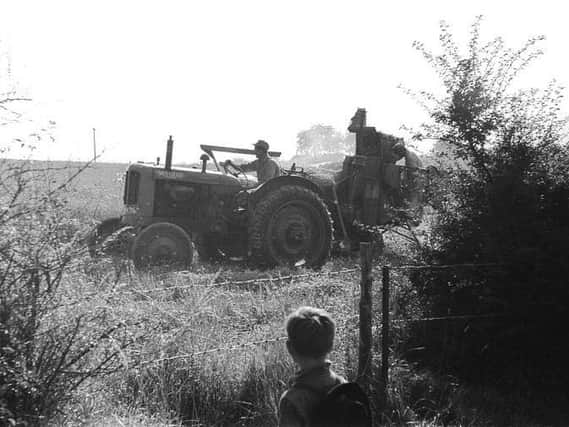Paradise lost? - How urban sprawl has destroyed much of Rugby's beautiful countryside


Waterways played a significant part during my younger days, as was no doubt the case with many older Rugby Advertiser readers.
After all, there was plenty to choose from. We had the Avon, Oxford canal, Newbold Quarry, Stanford Hall lake, Guilsborough reservoir, the big pond in Montilo Lane, River Swift… and the Old Arm.
Advertisement
Hide AdAdvertisement
Hide AdAh yes, the Old Arm. In the days of my 1950s Churchover childhood, this was – even back then – a disused branch of the Oxford canal, which in turn was served by what was known as the ‘Feeder’, a man-made branch of the Swift.
There may still be a few Rugby area fishermen around who will recall that the Old Arm contained some very large pike, often to be seen in high summer basking near the water surface, pinning you with their crocodile-eyed stare.
Anyway, all this profusion meant endless adventures. There was fishing, swimming in summer, and skating back in the days when we had real winters.
My father and I also had endless fun sailing a model yacht from side to side of the Feeder.
Advertisement
Hide AdAdvertisement
Hide AdAnd Nature was everywhere. The rivers and canals teemed with fish, the ponds with amphibians. For example, there was a pond in Churchover which was full of common and great crested newts.
Many of these ended up in garden aquariums made from old tin baths and either eventually escaped or were killed by cats. It is now illegal to attempt to capture a great crested, let alone take one from the wild.
Years before youngsters went ‘pond dipping’ I would take my home-made net down to the Swift and capture all manner of invertebrates.
There were great diving beetles – these could deliver a painful bite –bullheads, loaches and leeches. The most highly prized were the caddis larvae with their bizarre forms of protection, ‘cases’ made from small stones, various debris and water plants.
Advertisement
Hide AdAdvertisement
Hide AdAnd in the summer, the Swift Valley would come alive with the ‘little bit of bread and no cheese’ call of the yellowhammers and their close relatives the corn buntings, whose twittering song seemed to echo the sound of the water running over the riverbed stones.
My second book Beef Cubes and Burdock: Memories of a 1950s Country Childhood is a narrative of those care-free days and how I wish the area I once knew so well had not been so drastically changed.
But unfortunately this is not the case. All I saw in the Swift when I called were a few basking trout, no coarse fish at all. There were dragon and damselflies, but the formerly common water vole was nowhere to be seen.
What had once been the domain of rooks and lapwings was now covered with the Rugby Gateway development. Urban sprawl is now less than a mile from Churchover, with the air full of motorway ‘hum’ rather than the owl’s hoot.
Advertisement
Hide AdAdvertisement
Hide AdParadise lost? Mercifully, not quite. And for that we have to thank Warwickshire Wildlife Trust which has managed to save the last remaining area of what was once a haven for Nature.
Swift Valley Nature Reserve lies just north of Rugby and, while it may be hemmed in by modern developments, nevertheless provides a vital green lung in what would otherwise be an urban environment.
It also serves as a reminder of how much of this landscape, which once surrounded the town, has been lost over the last few decades.
Access is from the A426 Leicester Road, the route taking the visitor down Lower Lodge Lane, then following Brownsover Lane until reaching the reserve.
Advertisement
Hide AdAdvertisement
Hide AdOnce of the first things that you notice are the ridge and furrow fields. It was once thought that these were the remnants of mediaeval strip farming, but the thinking these days is that the contours were shaped because of the turning space required by a horse or oxen-drawn plough.
Over the years, the soil would gradually bank up, hence the ridge and furrow effect.
The list of creatures either found or visiting the area makes for encouraging reading. From rare beetles and other insects, to top predators such as the hobby, kestrel and fox, the reserve provides a tantalising glimpse of how it once was in the countryside all around Rugby.
There will be many people who will point out that the march of progress cannot be halted. But while there is indeed some truth in that, it’s the pace of change that is worrying.
Advertisement
Hide AdAdvertisement
Hide AdIn the relatively short timescale of my own lifetime, a landscape that had remained more or less untouched since the age of the enclosures, has now been changed out of all recognition.
And what’s been done probably can’t be undone. But thank heavens for the work of Warwickshire Wildlife Trust, which has preserved a corner of our beloved county not just for people around today, but also for those who come after us.
John Phillpott’s second book Beef Cubes and Burdock: Memories of a 1950s Country Childhood published by Austin Macauley is available from booksellers and online.